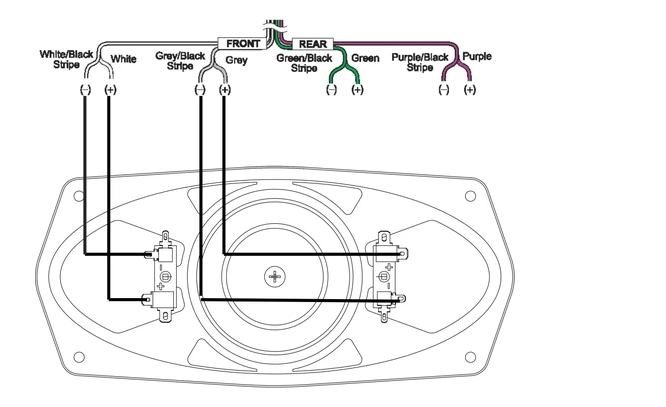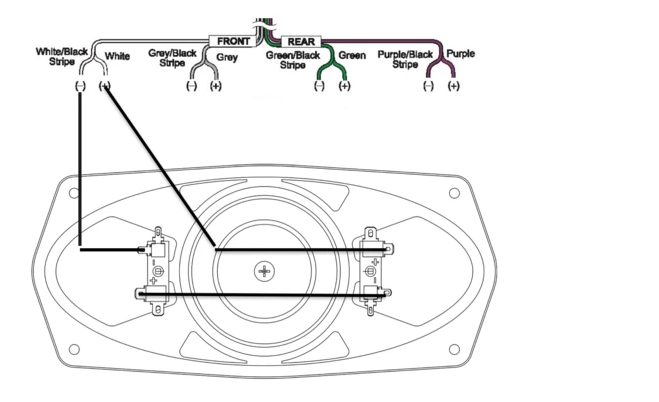Speaker Basics
How To Articles
Ray Smith
Last Update 4 jaar geleden
Types of Speakers
Our speakers come in many different sizes and configurations. We will cover the basic types in this tutorial.
There are a few things to consider when choosing speakers. How many speakers do you want or need? More important, what type and size do you need? Many classic vehicles have only one speaker mounting location, usually in the center dash or console. Other vehicles may have multiple speaker locations.
For vehicles with only one speaker location we recommend a dual voice coil dash replacement speaker. A dual voice coil speaker allows you to connect both a right and left speaker outputs from your radio to one speaker, providing you with a stereo mix from a single speaker location. These types of speakers are generally used in vintage vehicles that only have one speaker location in the dash, the rear deck or between the rear seats. The ability to connect both stereo channels to one speaker provides a fuller, richer sound than a mono or single voice coil speaker will.
For cars with multiple speaker locations, using stereo pairs of single voice coil speakers will work best.
Coaxial speakers in automobiles are two or three-way loudspeakers in which the tweeter (or the tweeter and a mid-range driver) are mounted in front of the woofer, partially obscuring it. These are the most popular speakers for automotive applications.
Component systems have a tweeter and mid-bass speaker that are mounted separately. These usually come with a crossover to send the high frequencies to the tweeter and the low frequencies to the mid-bass speaker.
A subwoofer is a speaker that reproduces low bass frequencies. A subwoofer is usually combined with a crossover and a speaker enclosure for optimum performance.
What fits my car?
If you are replacing factory speakers you will need to know the proper size. If you have the old speakers you can measure them. Most automotive speakers are either round or oval. To find the speaker size, measure the outside diameter of the speaker; for an oval speaker measure both length and width. (For example, an oval speaker might be 6×9-inches or 5×7-inches; a round speaker might be 5 ¼-inches or 6 ½-inches.) If there are no speakers in the vehicle, measure the speaker opening. If the opening is round, you will need to measure the inside diameter of the opening. If you have an oval-shaped opening, measure the inside length and width of the opening. This will give you a good idea of the size of the speaker you will need. When measuring the mounting depth, be aware of anything that may be in the way of the back of the speaker, such as air conditioning ducting, wiper motors, or other parts. Make note of the location of mounting holes; in some cases, you may need to drill new holes.
Installing Your Speakers
Now that you have the right size and type of speakers for your car, it is time to install them.
1. Determine where the speakers will be mounted.
2. Remove the old speakers.
For door speakers, it may be necessary to remove your door panels or grills to access speaker mounting screws or nuts.
Rear deck or package tray locations may require removing grills from the top of the deck, and/or accessing the speaker from the trunk area to remove mounting screws or nuts.
3. While removing the old speaker make note of wires and speaker markings and label the positive and negative wires.
4. Check wires.
Be sure wires are sound and free of any breaks or wearing that may cause a short.
If needed, run new wires from your radio to the speaker location, avoiding any sharp edges or moving parts.
5. Test fit your speakers.
Be sure the speakers fit your location and that there is nothing blocking the back of the speaker.
If you need to drill mounting holes, make sure there is nothing in the way (i.e. gas tank, wiring, or other obstructions).
6. After test fitting, connect the positive and negative speaker wires to the speaker terminals. Be sure the polarity is correct (positive wire to positive terminal; negative wire to negative terminal). If the polarity is reversed you will have little bass response and poor overall sound quality (see speaker wiring tips).
7. Secure the speaker using screws or nuts, making sure not to pinch any wiring.
8. Replace any grills or panels you removed.
Speaker Wiring Tips
Single Voice Coil (SVC) Speakers
Single voice coil speakers have positive (+) and negative (-) terminals. Each will be connected to the positive (+) and negative (-) outputs of your radio (see diagram below).If you are wiring just two speakers, remember to cap off the unused speaker wires.

Dual voice coil (DVC) speakers (dash speakers)
Dual voice coil speakers can be wired treating each voice coil as an individual speaker. This type of connection will give you the best sound possible.
Using the radio’s left and right front speaker outputs, connect the left positive (+) and negative (-) wires to one side of the dual voice coil speaker and the right positive and negative wires to the other (see diagram below)

You can also wire only one speaker output from the radio to wire the speaker in series. This method is not recommended, because the result will be mono sound instead of a stereo mix. Connect one voice coil negative to the other voice coil positive. Then connect ONE speaker output to the remaining positive and negative.
See Diagram below


